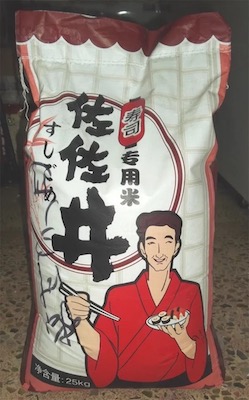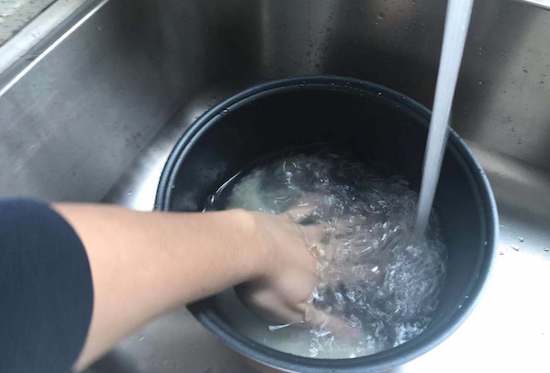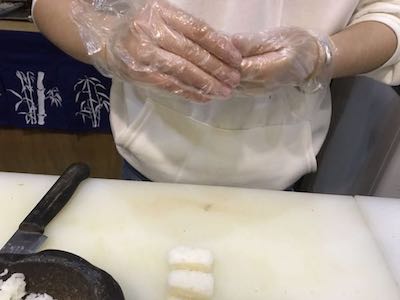We are reader supported. When you purchase through links on our site, we may earn an affiliate commission. Also, as an Amazon affiliate, we earn from qualifying purchases.

When I started my journey of learning to make sushi at home, the first thing I focused on was how to cook perfect sushi rice. Even though rice is one of the most undervalued ingredients used in this delicacy, the truth is that sushi rice can spoil the sushi if it becomes too sticky.
Sushi beginners often ask me ‘why is my sushi rice too sticky?’. Well, there can be several reasons such as not using the correct variety of rice, not washing the rice properly before cooking, using too much vinegar, adding excess water than the measured quantity, and cooking longer than required.
If the sushi rice becomes too sticky, it will not only stick to your hands like crazy but also not taste right when used in sushi rolls. Forget about making nigiri because creating that perfect form is impossible with gooey rice that lacks texture.
In today’s post, I will discuss the various things that can make your sushi rice too sticky and if possible, some fixes to make it usable. So, let’s get started.
Choosing The Right Type Of Sushi Rice
To make sushi at home, you need to get the essential supply from the nearest Asian grocery store. The first thing on the list should invariably be short-grain rice. In the grocery store or supermarket, you will find packets labeled as sushi rice, which refers to the short-grain Japanese rice.

Some people confuse sushi rice with sticky rice, but they are different things. When cooked, sushi rice has a sticky texture but it is still manageable. Sticky rice is a different variety which becomes very sticky when cooked and it is meant to be used in different dishes other than sushi. I have created an article that explains what is sticky rice and how it is different from sushi rice.
To get the right texture for sushi, ask for the shinmai variety of short-grain Japanese rice. Shinmai means the most recently harvested crop and they yield the best results when cooked. I have created a guide that can help you with the 10 Best Sushi Rice Brand (Perfect For Sushi).
Not Washing Rice Properly
If your sushi rice is too sticky, it could be probably because you did not wash it properly before cooking. To get that beautiful fluffy rice, you need to wash the uncooked grains a few times. Hold the sieve under tap water and rub them gently as you wash. Keep washing until the water running out is no more foggy.

The grains have a powdery coating of starch that tend to make the cooked rice too sticky. So, I advise washing the rice thoroughly to remove as much starch as possible. Don’t overdo this step because you still need some amount of stickiness in sushi rice.
You should also be careful while rubbing the grains between your fingers. Be careful to not break the grains as broken rice will not yield the same results. Also, remember to soak the rice for at least 30 minutes before cooking to get that ideal texture.
In some grocery stores, you will find the pre-washed type of rice. I would suggest that you do not buy this variety because some amount of starch is necessary to make the rice stick to the nori sheet or form a shape without falling apart.
Methods Used For Cooking Rice
Sushi rice can be cooked in a pot or electric cooker, but each has its own set of advantages and disadvantages. Cooking rice in a pot is the traditional method and the biggest advantage is that you can see the rice cooking in front of your eyes, check the progress, and adjust a few things if needed.
However, I would not recommend beginners to cook rice in a pot because it requires good amount of experience and expertise. It takes sushi chefs several years of practice to get this right. As this is a manual process, a little negligence or delay can make your rice sticky and soggy.
If you haven’t cooked rice before, get a low-cost electric cooker instead. You will just need to add washed rice and water up to the mark, as mentioned in the instructions. Some rice cookers in the higher range come with various settings to give you the perfect umami flavor. I have created an article that provides step-by-step instructions on how to cook sushi rice in a cooker and pot.
Using Too Much Vinegar To Season Rice
The tradition to dress sushi rice with vinegar goes back to the origins of this dish. When people began mixing rice with vinegar, they stopped discarding it and consumed the tasty rice with fish. However, it is important to add the right amount of seasonings or else you may end up making the rice too sticky or messy to handle.
To get the perfect texture, allow the cooked rice to cool slightly before adding vinegar to it. For every 3 cups of short-grain rice (uncooked), use about 1/2 cup of rice vinegar. Take this measurement as the yardstick and adjust the vinegar measurement depending on how much rice you cook. You can also add a little sugar and salt to vinegar, based on how sweet or salty you want the rice to be.
When the steam stops rising from the cooked rice, drizzle vinegar on the rice and toss with a wooden paddle to ensure that each grain is properly coated. Hold a fan on the other hand and keep fanning as you mix the vinegar to cool sushi rice. This can be a little tricky but if you are able to do this correctly, you will have perfectly seasoned and glossy sushi rice.
Adding Too Much Water
This is one of the biggest culprits that may make your sushi rice too sticky. No matter how confident you are about cooking rice in a pot, always measure the right amount with a standard cup. I still do because a small mistake can end up wasting my efforts.
When cooking rice in a pot, always soak the rice beforehand for at least 30 minutes. To cook rice in a way that grains separate easily, add 120% water to the rice quantity. For every 100 grams of rice, add 120 ml water to the pot. Cook with the lid on until water starts boiling, then simmer for 15 minutes and the rice will be done.
When cooking rice in a cooker, always stick to the 1:1 ratio. So, if you add 3 cups of washed rice to the cooker, you will need 3 cups of water to get the right texture. If you want to buy a rice cooker but so many options leave you confused, check out my reviews of the best rice cookers under $200.
Cooking Longer Than Required
This point is ruled out if you are cooking rice in a cooker because you set a time after which the cooking will stop. However, if you are making rice in a pot, be careful about not overcooking because this will make the rice too gooey for sushi.
If you are using short-grain rice, 15 minutes simmer after the water reaches the boiling point is enough to achieve the right texture. For those who use substitutes like medium-grain rice, may need to cook a bit longer because the grains are firmer and take time to cook.
Check the rice once it’s cooked by pressing a few grains with your fingers. If it feels too sticky, don’t cover the lid. Use a fan to cool the rice quickly so that it does not cook any further. Avoid tossing the rice with a paddle at this stage as the rice can break easily.

